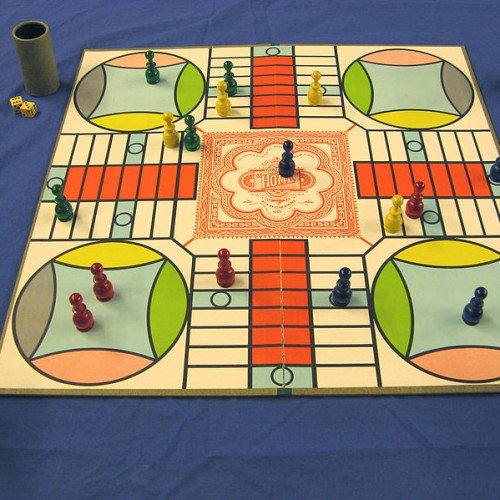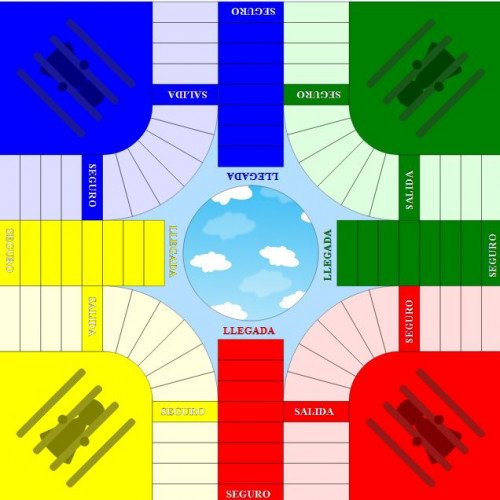"PARCHEESI" vs "PARQUÉS"

PARCHEESI
Parcheesi is a brand-name American adaptation of the Indian cross and circle board game Pachisi, published by Parker Brothers and Winning Moves Games USA. Parcheesi is typically played with two dice, four pieces per player and a gameboard with a track around the outside, four corner spaces and four home paths leading to a central end space. The most popular Parcheesi boards in America have 68 spaces around the edge of the board, 12 of which are darkened safe spaces. Each corner of the board contains one player's nest, or starting area. A player rolls the dice and must use the top die pip values shown to move their pieces around the board in one of the following ways: Only pieces not in the nest may move forward on the board Pieces may only leave the nest with a roll of a five on a single die or the sum of the dice. A double five can be used to move two pieces from the nest simultaneously. In the case of a non-doubles roll, a player may move one or two pieces, either one piece by each of the numbers on the two dice or one piece by the total. If no move is possible, the turn is forfeited. When moving a single piece the total of two dice the turn is taken in increments, allowing pieces to be captured along the way. For example, if a double two is rolled and an opponent's piece lies on a cream space two spaces in front of the piece you wish to move the full four, you would move the piece two, and then two again, allowing the opponent's piece to be captured. All die rolls must be taken and may not be voluntarily forfeited by a player. If a player cannot use both dice, the player must use one of the dice, if possible. If either can be used, the player must use the largest die. All die moves must be taken before the application of any extra rewards for sending an opponent to their nest or moving a piece to its home position. With a roll of doubles, the player makes four moves, one for each of the numbers on top of the two dice and one for each of the numbers on the bottoms. The player may distribute these four moves among one, two, three, or four pieces. Note that the sum of numbers on the opposite sides of a die is always seven, so with doubles, there are a total of fourteen spaces to move. This can only be done if all four pieces are out of the nest. When the player rolls doubles, the player rolls again after moving.
Statistics for this Xoptio

PARQUÉS
Parqués (Spanish pronunciation: ) is the Colombian version of a board game in the cross and circle family (the category that includes Pachisi). The game is described as a "random thinking" game: the moves depend on the roll of the dice but players must consider possible strategies before executing their move. The objective of the game is to advance all the pieces to the end.Once in the safety zone player can use 2 dies until they are one space away from home, where they will then just use one die. Parqués is the Colombian version of Parcheesi, which itself is a version of Pachisi (which originated in India). The meaning of the word may be a translation of the pachisi word, also influenced by similar games such as Parcheesi. Parqués as a word in another context has no meaning. Although it could be argued that the game's origin is Spanish (from Parchís) due to the similarity between both games, there is wide agreement in Colombia that the game is completely Colombian. Parqués stems directly from Pachisi in the same way as Parcheesi, Parchís or Ludo. There is no proof to the claim that it stems from a country other than India, up to date. Moreover, no Parqués game is played in any other Latin American countries. Parqués is a mixture of the original Indian game and the influences of local Colombian culture. In Colombia, people from all parts of the country play the game and there are local variations of it. It is very popular; played by both children and adults. Adults usually play the game by betting money on the first piece, on capturing pieces, or on winning the game, to make gameplay more interesting. There are boards for 4, 6 and 8 players. The boards usually contain pictures of soccer teams, singers, actors, or other cultural figures on the jail boxes. Also, most boards are made by fans of the game, by drawing and framing them. The board itself is usually placed on a box covered by glass. The use of glass is to allow dice to be thrown more easily. There are versions of the board that are made of paper to make it portable.